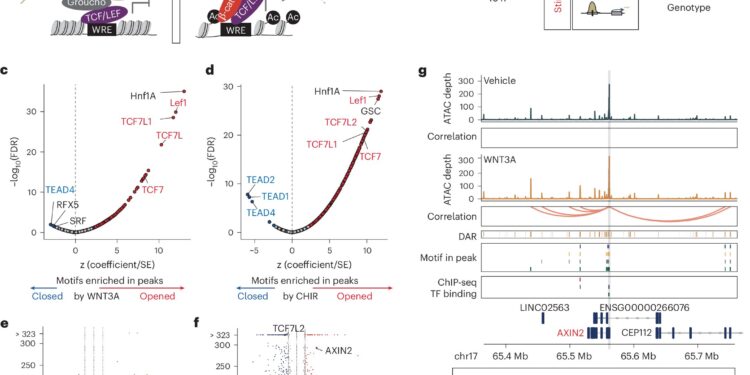Changes in gene regulation induced by Wnt stimulation. ACartoon of the canonical Wnt signaling pathway. bStudy design outline. Enrichment of TF motifs in response to WNT3A (c) or sensitive to CHIR (d) chromatin accessibility peaks assessed by logistic regression. Z scores reflect scaled enrichment scores (x axis), and −log10(FDR) describes the importance of enrichment (Yes axis). Volcano plots show gene expression changes induced by WNT3A exposure (e) or CHIR (f). DEGs were evaluated by two-sided negative binomial generalized linear models. (g) WREs are significantly correlated with AXIN2 expression upon WNT3A stimulation. DAR, differentially accessible chromatin regions measured by ATAC-seq. The region’s DARs and TSSs overlap with TCF/LEF motifs and Wnt-relevant TF binding from previous ChIP-seq experiments. P. values were adjusted using the Benjamini–Hochberg procedure (c–f). FC, fold change; NS, not significant. Credit: Natural neuroscience (2024). DOI: 10.1038/s41593-024-01773-6
For many years, scientists have known that genetic variants, or differences in DNA code from one person to another, play a role in neurological and psychiatric disorders. But the details were murky. Today, researchers at the UNC School of Medicine are using a combination of cell line and DNA sequencing approaches to closely examine our genomes and identify genetic variants and genes that play a role in the influence of the risk of neurological and psychiatric disorders.
A research team led by Jason Stein, Ph.D., associate professor of genetics and member of the UNC Center for Neuroscience, used a living cell model system of the human brain to identify the function of genetic variants important for increasing the risk of developing schizophrenia, autism spectrum disorder and bipolar disorder. The results were published in Natural neuroscience.
“There are hundreds of different locations on our genome that are associated with psychiatric disorders,” said Stein, who is also a member of the UNC Lineberger Comprehensive Cancer Center. “But these locations are in regions of the genome whose function is not well understood. We hypothesized that some genetic variants only function when stimulated by certain neural pathways important for brain development.”
Of our entire genome, only 3% is responsible for creating codes that lead to the formation of proteins, the “machines” that carry out necessary tasks in our bodies. The remaining 97% of the genome does not code for proteins. It is in these “non-coding” regions that we find most of the genetic variants implicated in psychiatric diseases.
Non-coding variants should be similar to light switches. They can “turn on” and “turn off” genes that code for proteins. But finding the precise function of these non-coding genetic variants has proven difficult for researchers. Indeed, “non-coding” genetic variants may have a “context-dependent” function, meaning that they only function when specific cellular pathways are stimulated. In other words, the downstream effects of these genetic variants can only be observed when the brain cells are alive and responding to stimulation.
The Stein lab decided to study the function of these genetic variants in neural progenitor cells, which are cells involved in brain development. Each cell line has a different genetic background, allowing researchers to compare and contrast genetic variants in active and inactive states. Members of Stein’s lab exposed the stem cells to different chemical compounds and controls to measure differences in response.
These compounds stimulate the Wnt pathway, a cascade of proteins that play an important role in brain development. Using the living model, researchers discovered thousands of non-coding genetic variants whose function depends on context.
“Through activation of Wnt-responsive genes, we found variants whose function depends on context and which are involved in schizophrenia risk,” Stein said. “The discovery of these genetic variants represents an important step in our understanding of the mechanisms that put a person at greater risk of developing a neuropsychiatric disorder.”
Stein said a similar study design using this living cell model system of the human brain could be useful for testing how genetic variation influences the risk of environmental exposures, such as lead exposure, and their impacts on the brain. Likewise, future applications of this approach could be used to prescribe psychiatric treatments based on an individual’s genetics.
Co-first authors of the study were research associate Nana Matoba, postdoctoral fellow Brandon D. Le and graduate student Jordan M. Valone.
More information:
Nana Matoba et al, Stimulating Wnt signaling reveals context-dependent genetic effects on gene regulation in primary human neuronal progenitors, Natural neuroscience (2024). DOI: 10.1038/s41593-024-01773-6
Provided by the University of North Carolina at Chapel Hill School of Medicine
Quote: Living cell model system can decode genetic risk of psychiatric disorders (October 3, 2024) retrieved October 3, 2024 from
This document is subject to copyright. Except for fair use for private study or research purposes, no part may be reproduced without written permission. The content is provided for informational purposes only.



